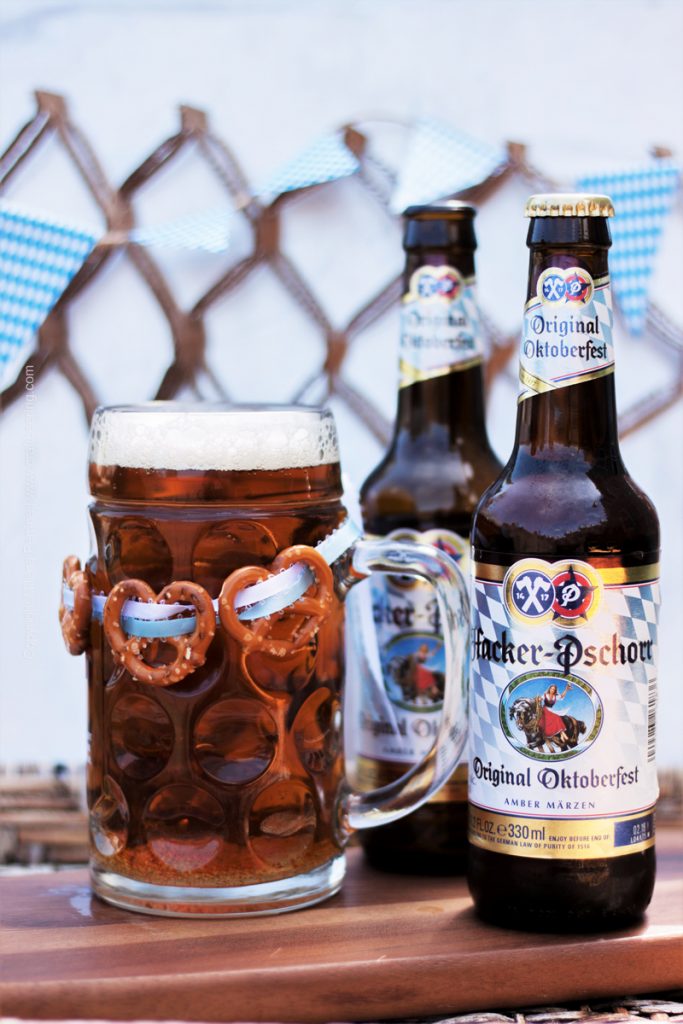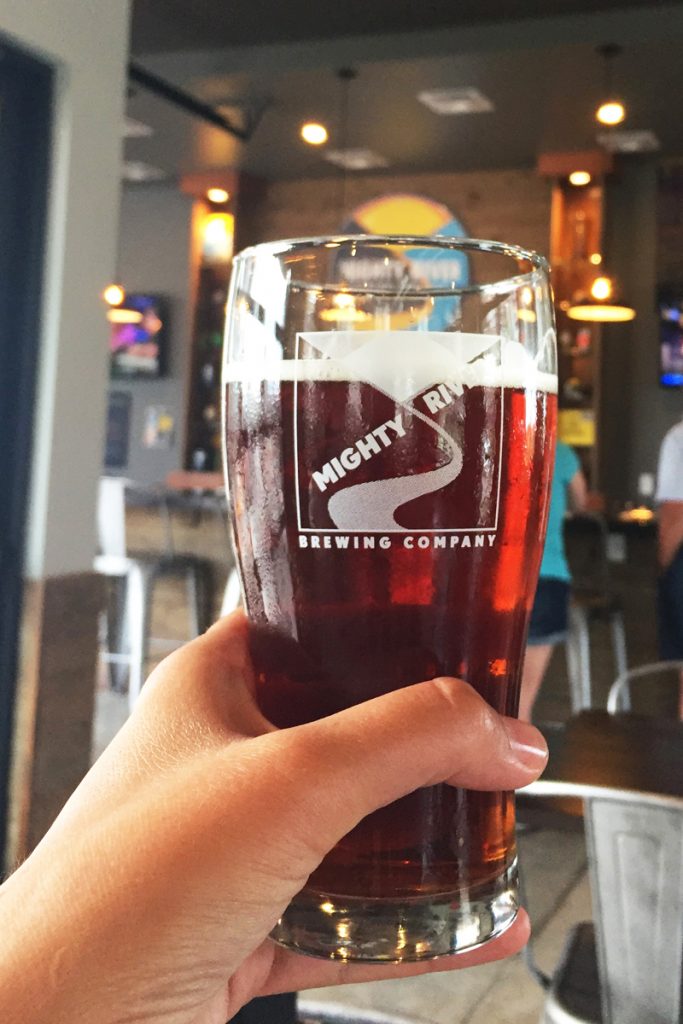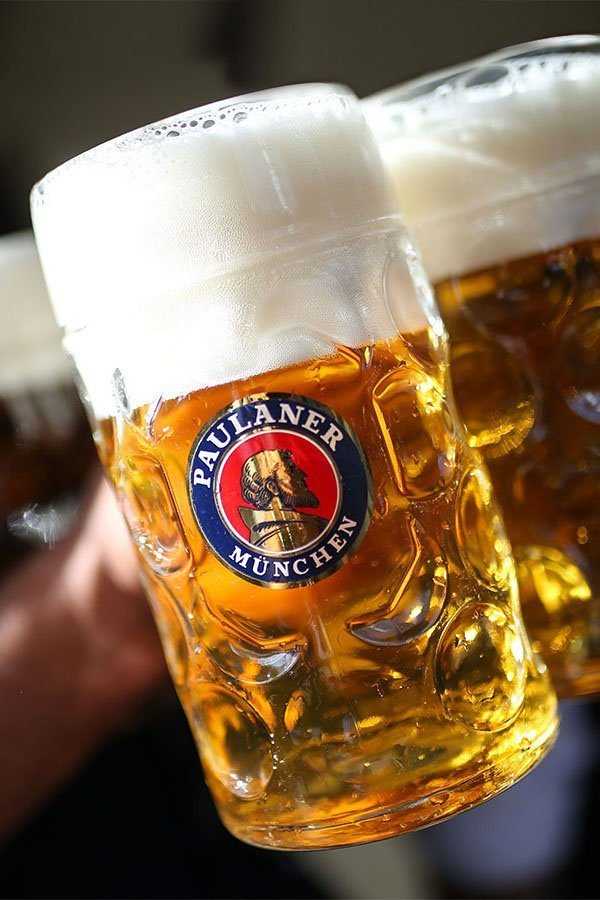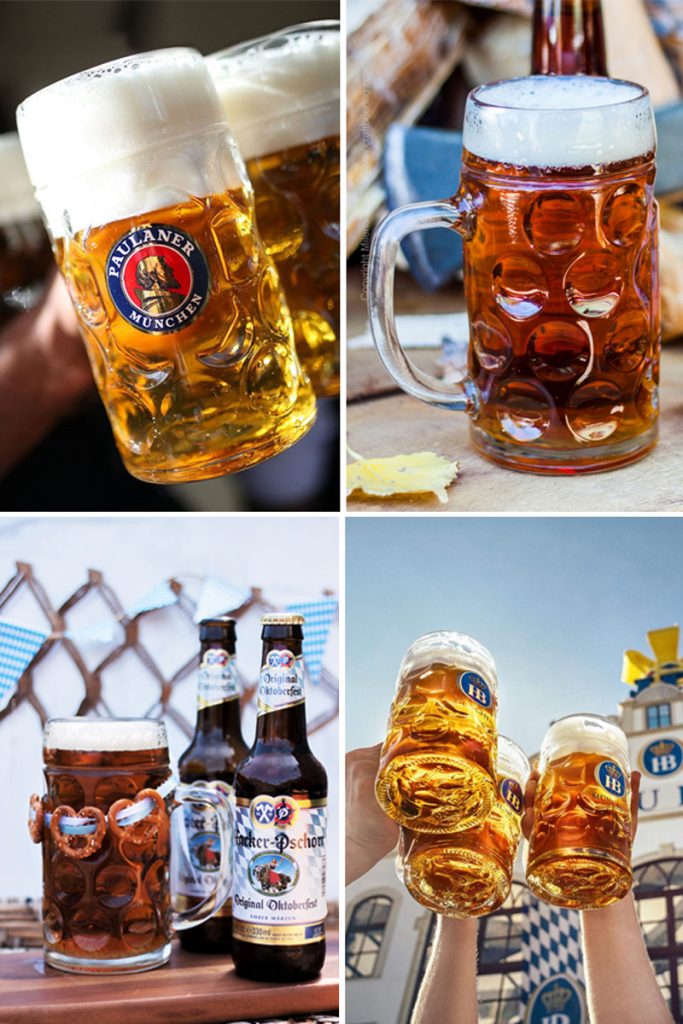We bring clarity to the Oktoberfest beer vs Märzen vs Festbier vs Oktoberfest style beer riddle.
Most people seem to be primarily interested in drawing a distinction between Oktoberfest bier and Märzen, but things are a bit more complicated than that.
We recommend that you read the whole post below to gain a solid understanding of which beer style is which (3 mins).
Oktoberfest vs Märzen
The shortest answer to the Oktoberfest vs Märzen riddle is this:
Oktoberfest beer (in German Oktoberfestbier) is the beer served on the Wiesn during the annual Munich Oktoberfest festival.
It used to be a Bavarian amber lager, known as modern Märzen but in the 1970s was replaced by a much lighter lager known as Festbier.
This is not all – there are a quite a few intricacies surrounding the identities of Oktoberfest beers. The easiest way to explain them is by outlining a timeline of the beer related events specific to the Oktoberfest.
By the time you finish reading this post, you will not only understand the fine distinctions, you will feel confident explaining them to others.
Oktoberfest Beer Time Line
1. The First Beers Served at Oktoberfest
In the beginning all beer served at the Oktoberfest was of the dark lager kind, the beginnings of today’s dunkel lagers. This was because the kilning techniques at the time could only produce dark malts.
As advances in kilning technology made by the British resulted in lightly kilned malts, the Germans took note, adopted the new methods, experimented with kilning locally grown barley and created new, lighter malts and hence new styles of lagers. Initially they improved dunkel and brewed it with Munich malt. Dunkel was the beer style first served during the fest.
CURIOUS FACT: Beer was first served at Oktoberfest in 1818. Before that the event commemorating the celebration of Ludwig of Bavaria and Princess Therese von Sachsen-Hildburghausenthe wedding was organized as an agricultural show with a focus on harvest and food.
2. The Onset of Amber Lagers
In 1841 the Spaten brewery introduced a lighter colored, amber lager also made with Munich malt but in combination with a very lightly kilned pale malt.
This new easy drinking beer was called a ‘modern Märzen’ and gradually replaced dunkel to became the official beer of the Oktoberfest in 1872. See below for exactly how the Märzen style evolved.
3. Amber Lagers Give Way to Golden Festbiers
Festbier is an actual German lager style that came to replace the Märzen lagers served during Oktoberfest in the late twentieth century. Golden in color and very easy to drink it was developed and pioneered by Paulaner. The brewery debuted it during the festival in the early 1970s. See below for full style description.
The style appealed to attendees and by the 1990s all the beer served at the Oktoberfest was festbier and Märzen had been officially replaced.
Today festbier is THE Oktoberfestbier on the Wiesn.
CURIOUS FACT: To this day a great deal of confusion surrounds the use of the names Oktoberfestbier and Festbier. It stems from country specific practices.
While there are no rules set in stone, typically Oktoberfestbier (Oktoberfest beer) is used to reference the beer served on the Wiesn (which style wise happens to be festbier today).
Only the following six Munich based breweries are allowed to name their beers for the festival Oktoberfestbier.
Any other brewery must call their seasonal lagers, amber or golden Oktoberfest style beer. At the same time Festbier is often used outside Germany to describe today’s Oktoberfestbier.
4. In the US Oktoberfest Style Beer is Considered to Be Märzen Amber Lager
As we clarified above, because the Oktoberfest is a Munich festival organized primarily for the residents of Munich and the surrounding areas of Bavaria only Munich breweries can brew Oktoberfestbier for the fest and sell it on the Wiesn.
Everyone brewing seasonal amber lagers anywhere else in the world but inside Munich city ‘walls’ makes Oktoberfest style beer, not Oktoberfestbier (Oktoberfest beer).
In the US an Oktoberfest style beer is assumed to be a Märzen style lager.
Definitions
Below we formally define each beer style (safe to say each lager, for there are no ales involved here) mentioned above.

Märzen
What is a Märzen?
Märzen is a German amber lager – dark copper to reddish brown in color, crisp but also smooth, with sweet toasted bread aroma and faint hints of spice. It is sweetish but with a noticeable Noble hops bite and a dry finish. The typical ABV is 5-6%.
The style as we know it today was introduced by the Spaten brewery in 1841 and was then further tweaked and developed. Its origins go farther than that however, possibly back to 1553 when summer brewing was prohibited in Germany.
The name Märzen means “March beer”. It applies to beers brewed in March and left to lager (condition) in cold cellars over the course of the summer, to be tapped in early fall. Summer brewing was for a long time prohibited in Germany in order to ensure good beer quality and prevent spoilage in high temperatures.
These March beers were brewed with higher gravity (alcohol content) than regular lagers in order to have the longer shelf life needed to make it to the harvest festivals. They were much darker than today and only became amber in color after the Spaten brewery experimented with lighter malts and developed the style we are familiar with today, often referred to as modern Märzen.
What is Oktoberfest Beer (Oktoberfestbier)?
Oktoberfest beer (Oktoberfestbier) is formally defined as a beer brewed by one of the six big Munich breweries allowed to serve their product on the grounds of the Oktoberfest.
These used to be amber lagers but today are much lighter in color – see definitions for Märzen above and Festbier below.

Vienna lager
What is a Vienna Lager?
I must mention Vienna lager here because this style is practically the same as modern amber Märzen but originated in Vienna. When it was first brewed it was said to be a “Lagerbier nach Wiener Art” which essentially means “Lager beer in Viennese style”.
Vienna lager is a style very similar to Märzen but lighter in color due to the use of Vienna malt. Typically less malty and a bit more bitter than Märzen, with ABV of 4.5-5.5%.
In brief, Vienna lager was the result of the work of an Austrian brewer, a very skilled one, by the name of Anton Dreher.
He was also influenced by the English kilning achievements and decided to use produce and use paler malts. He still used Bavarian lager yeast and created an elegant maltiness balanced by firm, but not pervasive bitterness. He was known to describe his amber lager as a “new Märzen”.

Festbier / Picture credit: Paulaner
What is a Festbier?
Festbier is a strong golden German lager with great, long-lasting white head. It has traits similar to Helles and Maibock – malty backbone, spicy and floral hop bite, moderately full body and a dry finish. The ABV is 6-6.5%.
Festbier was pioneered by Paulaner, especially to be served for Oktoberfest. Eventually all the other breweries allowed to serve on the Wiesn made their own versions and today Festbier is THE lager exclusively brewed for and served at the annual Oktoberfest celebration.
It has a deep gold color, the mash contains both pilsner malt and Munich malt and showcases bready notes with a rich flavor underpinned by a moderate sweetness.

Oktoberfest style beer
What is an Oktoberfest Style Beer?
Oktoberfest style beer is a lager, usually in the style of German Märzen brewed by a brewery located anywhere outside the city limits of Munich.
In the US the predominant opinion is that Oktoberfest beers are amber Märzens. So when you buy a seasonal amber lager in the US it will either be called Oktoberfest style beer or Märzen or some combination of both names.
American brewers commonly produce Märzen oktoberfests with a rich caramel color and taste sweeter than their German counterparts, with toasty and warm spice notes and an underlying restrained hop bitterness.
Vienna lagers are also brewed as a seasonal option by a number of craft breweries.


mpzz says
It’s hard to believe that Germans are weak enough beer drinkers to accept the “lighter” beer for Oktoberfest, and that weak, light beer-drinking Americans still have the real Oktoberfest marzen beer exclusively. For one thing, anyone that has ever drank American Oktoberfest beer knows it is not “heavy” or difficult to drink at all! Having more character and flavor and a darker color does not make a beer less “easy drinking”. On the contrary, it makes it more of a pleasure to drink!
CraftBeering says
We feel very much like you! Real deal Marzen is so flavorful that we wait for it every year. Not that the lighter Festbier sold at Oktoberfest during the last few years tastes bad, but it really lacks the complexity of Marzen.
Jake says
I find the amber marzen beer heavy and hard to drink more than 1 or 2 of, and its sweet. I recently discovered this “festbier” served in Germany and I’m actually shocked that we Americans are 40 years behind the curve and still serving the old, sweet, amber/orange style here. I think the Germans’ new lighter style is hands down WAY better.
12ptrestaint says
A lot of American Craft Brewers are now doing lighter Festbiers. In my local market (Lincoln, NE) at least 4 of our locals are exclusively brewing Festbier style with no Marzen at all. I personally love both including one of the best in the country, from one of the best breweries in the country, Zipline!
Molly says
If you knew how much they consume on the Weisn, you wouldn’t be using the word weak. Many are drinking 3+ liters over the course of an evening of celebrating.
Plus, the more the breweries sell, the more money they make. Better for attendees to chug lighter beers than sip something else…$
Leanne says
I started reading this post to myself, but my hubby is sitting next to me, so instead of sending it to him, I just started reading out bits of the history you shared. We’re not beer experts, but love learning more about it and drinking it, of course! Always learn something new when I stop by here. Thanks guys!
CraftBeering says
Thank you for the kind words, Leanne! The Oktoberfest beers definitely deserve an explanation given how confusing the terminology that surrounds them can be.
Jaxx the Bearded Hiker says
You guys are my heroes.
CraftBeering says
OK..:) Thanks Jaxx!
Leslie says
What an interesting history lesson on seasonal beers! Thanks so much for sharing at the #happynowlinkup!
CraftBeering says
Thank you Leslie! Love the history of beer and how different styles evolved, always helps me appreciate the style more.
Leanna says
Very interest post, I am beginning to know much much more about beer. Thank you for the information.
CraftBeering says
I have a feeling you will love many of the German styles. We are waiting on an Altbier to second ferment with blackberries and bourbon soaked French oak chips, totally Chris’ creation. It tasted pretty good after the first fermentation last night, so very hopeful for the end result. I cannot wait to cook a dish or two with it. Similar beers are quite pricey (since labor, equipment and time intensive) so we mostly drink them, lol.
annie@ciaochowbambina says
I always learn something new when I come by your blog! Thank you for that! Plus – have I told you how much I love your styling? I feel like I’m sitting right there, enjoying a brew with you guys… Maybe someday! 🙂
CraftBeering says
Most certainly we will enjoy beers together some day:) Thank you Annie for the kind words!
Kelsie | the itsy-bitsy kitchen says
Loving this–I’m a history nerd, so am totally geeking out. But why was summer brewing forbidden way back when? I love how much I learn every time I stop by your blog :). Have a great week, and I can’t wait to see the recipes you guys have coming up!
CraftBeering says
Hi Kelsie! Brewing was forbidden in summer as part of the Rheinheitsgebot, (German Beer Purity Law) the scope of which extended past the four main ingredients to be allowed in brewing (malt, hops, yeast and water). It was thought that the risk of contamination was too high during summer so brewing had to end before the weather got too warm. That specific part was phased out once refrigeration was invented. I appreciate your question:)
Dawn - Girl Heart Food says
Girl, you are a wealth of knowledge! We have so many more styles and flavours of beer to choose from than ever before around here and I love it! Do you know that a very long time ago, I was not a fan of beer? That is totally not the case now, that’s for sure. I love trying new beers and there is definitely no better time than Oktoberfest 😉 Pretty neat about the trademarked name and only 6 breweries allowed to call their beer Oktoberfestbier. Bet they are pretty special 🙂 Cheers, my friend!
CraftBeering says
Ha, hardly, but I love reading about beer and summarizing what I learn:) Very drawn to beer, lol. Cheers! Hope you had a great weekend. I tried an amber ale aged in oak with shiitake mushrooms last night, it was so delicious, I quickly overcame my reservations. There was a very pleasant earthiness to it, and just a hair of raw shiitake aftertaste, very enigmatic. I would have never thought I’d like it until I tried it!
Noel Lizotte says
Will have to see if we can find this beer … my husband loves dark lagers. Very interesting history lesson. I think the pretzels on the ribbon are a great touch for parties. Altho, I’d guess most beer drinkers I know would think it’s frou-frou and just want their pretzels in a bowl LOL.
CraftBeering says
Our son requested his own pretzel garlands for snack at school:) They were learning about Oktoberfest in social studies (no beer tasting though, lol). He picked yogurt covered pretzels for his garland. I bet you now the moms of kids from his class are getting a request for pretzels on ribbons and are like “Ask your friend’s mom to make you a snack like that”…
Melissa says
Wow!! I honestly would not have known the difference!! My husband on the other hand, would probably shake his head at me as he is a beer lover!! I will have to send him your site so he can follow along!!
CraftBeering says
It is such a play of words isn’t it? Thank you Melissa.
Kelly @ Kelly Lynns Sweets and Treats says
Love this! Thanks for linking up at the Friday Frenzy Link Party! Pinned!
CraftBeering says
Thank you so much Kelly!
Mari says
Such a great informative post! Love the photos too! 🙂 I’ve never been to Oktoberfest but I hope next year… I’ve heard all the best about it, and you made it even more inviting! 🙂
CraftBeering says
Thank you Mari, hope you get to go too! It is a lot of fun!
Joanna @ Everyday Made Fresh says
We love the time of the year when all the Oktoberfest beers hit the market! We have a beer garden locally, but have never been. I’m thinking that we should head over for Oktoberfest this year!
CraftBeering says
It is exciting, such festive seasonal lagers that help transition from the beers of summer to winter favorites! Thank you for stopping by Joanna.